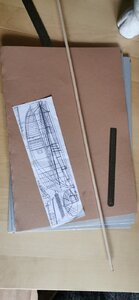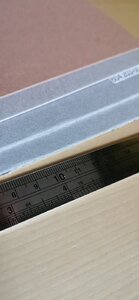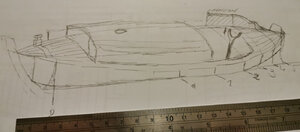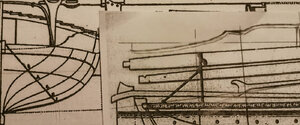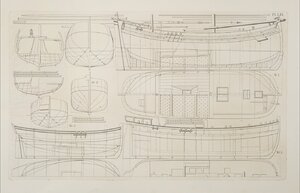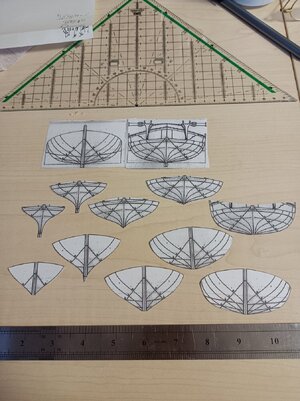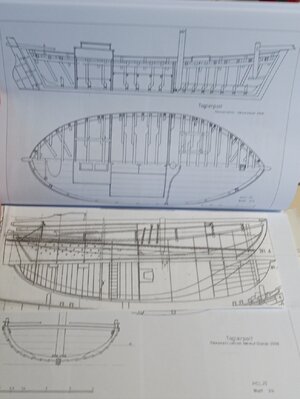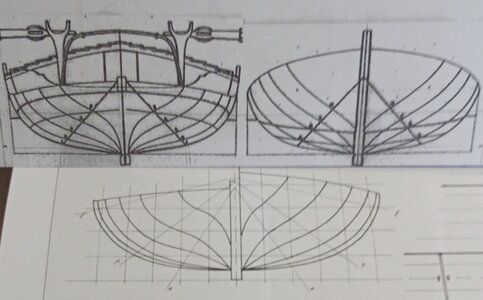Hi Guys,
since this small boat is covered, I hope to have a better chance of getting the display sensibly than with the open pleasure pin wet.

The plan comes from the Architectura Navalis Mercantoria and can be found on plate LX under number 4.
The small fishing vessel, which is not even 13 meters long, is referred to in the index as "life fish transporter with a well used around Stockholm".
This also explains the holes in the aft hull, because in the well the caught fish swam in the fresh water. So they came to the customers and chefs fresh even in summer. It was the case that the fishermen knocked off the contents of their net at the catcher in front of Stockholm directly in his box and were paid on the spot. As a result, they did not have to face the risk of selling, but only that of the already uncertain catch. The dealer then sailed to Stockholm and sold the freshly caught fish on the quay or in the market.
Like the fishing boats of the southern Baltic Sea (Helmut Olszak wrote about it), flat and very round shapes are predominant here. This hull shape developed to be able to drive with the uneven Baltic thinning.
Unfortunately, I find no more specific date than "dated before 1768" before the first edition of Chapmans Arch. Nat. Merc.
Dimensions:
- Length: 42 - 2/3 Engl. foot
- Width: 12 - 5/6 engl. foot
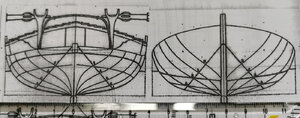
The hull has only two frames with a convex shape, otherwise everything is concave, which should make construction very easy. I find the clinker of the cabin roof and the supported iron bracket that leads the lower gaff tree interesting.
The masts are completely specified and I like that very much, I don't have to reconstruct anything. The rigging is certainly rewarded in red and probably in two parts, since the boat may have driven a large gaff sail and a jib. So far I have not found anything that indicates a second foresail. The lower gaff tree is moved with a hook on the mast, the shorter upper one with a rope and a claw.
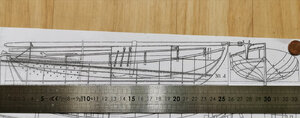
I scaled the plans to 1/48 and then printed out a copy set in 1/24 and finished it ready to build; so I'll start in 1/48 as the scale is quite confortable to work in...
My girlfriend builds, when she improves and sews on her beautiful little Tilda figures, I can work in the living room on her table on my cardboard pices with a cutter a steelruler and a glue. So I can work without too much machine tools. So it always goes ahead when we are sitting opposite each other and are creative in the same moment.
So there is progress especially on weekends.
So now it is time to search for materials for the construction of the inner hull.
So this is the start on this weekend.
since this small boat is covered, I hope to have a better chance of getting the display sensibly than with the open pleasure pin wet.

The plan comes from the Architectura Navalis Mercantoria and can be found on plate LX under number 4.
The small fishing vessel, which is not even 13 meters long, is referred to in the index as "life fish transporter with a well used around Stockholm".
This also explains the holes in the aft hull, because in the well the caught fish swam in the fresh water. So they came to the customers and chefs fresh even in summer. It was the case that the fishermen knocked off the contents of their net at the catcher in front of Stockholm directly in his box and were paid on the spot. As a result, they did not have to face the risk of selling, but only that of the already uncertain catch. The dealer then sailed to Stockholm and sold the freshly caught fish on the quay or in the market.
Like the fishing boats of the southern Baltic Sea (Helmut Olszak wrote about it), flat and very round shapes are predominant here. This hull shape developed to be able to drive with the uneven Baltic thinning.
Unfortunately, I find no more specific date than "dated before 1768" before the first edition of Chapmans Arch. Nat. Merc.
Dimensions:
- Length: 42 - 2/3 Engl. foot
- Width: 12 - 5/6 engl. foot

The hull has only two frames with a convex shape, otherwise everything is concave, which should make construction very easy. I find the clinker of the cabin roof and the supported iron bracket that leads the lower gaff tree interesting.
The masts are completely specified and I like that very much, I don't have to reconstruct anything. The rigging is certainly rewarded in red and probably in two parts, since the boat may have driven a large gaff sail and a jib. So far I have not found anything that indicates a second foresail. The lower gaff tree is moved with a hook on the mast, the shorter upper one with a rope and a claw.

I scaled the plans to 1/48 and then printed out a copy set in 1/24 and finished it ready to build; so I'll start in 1/48 as the scale is quite confortable to work in...
My girlfriend builds, when she improves and sews on her beautiful little Tilda figures, I can work in the living room on her table on my cardboard pices with a cutter a steelruler and a glue. So I can work without too much machine tools. So it always goes ahead when we are sitting opposite each other and are creative in the same moment.
So there is progress especially on weekends.
So now it is time to search for materials for the construction of the inner hull.
So this is the start on this weekend.



